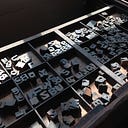Flannery O’Connor Childhood Home
207, East Charlton Street
Savannah, Georgia
“MARY FLANNERY O’CONNOR was born at St. Joseph’s Hospital in Savannah, Georgia, on March 25, 1925, into two of Georgia’s oldest Catholic families, the Clines of middle Georgia and the O’Connors of Savannah. The Savannah of O’Connor’s childhood was, of course, a decidedly smaller and more provincial version of the Savannah of today. […] The city itself was a beautiful historic setting, and the majest Cathedral of St. John the Baptist, located just across the square from O’Connor’s childhood home at 207 E. Charlton Street, provived the bedrock of the young writer’s faith.”
Sarah Gordon, A Literary Guide to Flannery O’Connor’s Georgia
This is the beginning of the chapter dedicated to Savannah, Flannery O’Connor’s birthplace, in Sarah Gordon’s A Literary Guide to Flannery O’Connor’s Georgia (2008). My quest this week has been that of looking for what is left of Flannery O’Connor’s first years in Savannah, Georgia, and this is why last Friday I embarked on a Greyhound bus headed towards the Atlantic Ocean. Once there, I was baffled and amazed by this city: even though so much seems to have changed since young O’Connor lived there, I felt as if I had been brought back in time. As someone told me while I was there, there is a legend about an old curse that was cast on the place so that the city would never change over the time. Indeed, this is exactly how one feels walking around Savannah— also because tourists are still going around in carriages and trolleys for the usual sightseeing tours. The old Southern fashion is still there, but one cannot forget that old shops have been replaced by convenient stores and that cars are now what carriages were more than a century ago. Even when reality sets in, there is still the weird, odd feeling of being and walking in another century. And this is exactly what I was feeling when I started towards Flannery O’Connor’s Childhood Home, located at 207 East Charlton Street. That was the main destination of my trip.
This is the first part of a photographic and written account of what I discovered there about the woman and the writer, especially thanks to the kind help of Toby Aldrich, who gave me an amazing tour of O’Connor’s house and who was patient enough to let me take all these photographs. Thank you very much, Mr. Adlrich.
The tour starts in the living room, where one can still see part of the original furniture of the O’Connors, as Regina, Flannery’s mother, put almost everything in storage when they moved first to Atlanta and then to Milledgeville. The color of the walls is the same one that supposedly constituted the background of O’Connor’s childhood, even though it was restored in the last decades according to the studies of a gradute student in the Savannah College of Arts and Design. The presence of green and gold is particularly important, as these two colors were associated with “Cousin Katie,” the woman who helped the family a good deal throughout her life. A photograph of Kate Semmes is still displayed in the room.
“A strong-willed woman who drove one of the few electric cars in Savannah at the time, Cousin Katie actually held the deed for Ed O’Connor’s house, and when the family left Savannah in 1938, Ed O’Connor, not having paid off the debt, relinquished the house to Mrs. Semmes. […] Mrs. Semmes willed the Charlton Street house to Flannery O’Connor who renovated it and rented it out as apartments until the time of her death in 1964.”
Sarah Gordon, A Literaty Guide to Flannery O’Connor’s Georgia
There are other interesting photographs in this room, starting from the mantlepiece, where the visitor can see three framed pictures: Edward F. O’Connor on the left; Mary Flannery and her mother, Regina Cline O’Connor, in the middle; and young Flannery, aged 3, on the right. Mary Flannery had a special relationship with her father, as she would write many years later:
“My father wanted to write but had not time or money or training or any of the opportunities I have had. […] I am very likely to romaticize him because I carry around most of his faults as well as his tastes. I even have about his same constitution: I have the same disease. […] At the time he had it there was nothing for it but the undertaker. […] Anyway, whatever I do in the way of writing makes me extra happy in the thought that it is a fulfillment of what he wanted to do himself.”
Sarah Gordon, A Literary Guide to Flannery O’Connor’s Georgia
Young Flannery appears in one more photograph together with a playmate, but by the time this photo was taken she had already decided to be through with childhood and declared that she was an adult — and wanted people to treat her as one. This caused a lot of tension between her and her teachers at the Catholic school she attended: as she didn’t want to go to the children’s mass and preferred the adult one, the sisters used to scold her every Monday morning. As Brad Gooch writes in his autobiography of the author, all she had to say to her teachers was: “The Catholic Church does not dictate to my family what time I go to Mass.” She had quite a temperament since she was a child and it is not difficult to guess which of these two girls is Mary Flannery.
Another interesting item is the baby carriage Regina O’Connor used to walk her daughter in: this is the original one from back when Flannery O’Connor was a baby as it is confirmed by the monogram on the side of the baby carriage itself — a gilded monogram, probably a gift from Cousin Katie. Although the interior of the carriage is partly ruined, it is still possible to see the strings with which baby Flannery was being held when she was inside it.
The monogram “MFO’C” comes back in the second room of the house, the Bruckheimer Library, entitled to the Hollywood producer and O’Connor’s fan who made a big donation to the Flannery O’Connor’s Childhood Home Foundation. Besides the books that used to be in her house when she was growing up and first editions of her works, one of the most interesting cabinet is the one containing her childhood books. Once she had read one, she used to write comments on them — usually, whether she liked that particular book or not — and signed it “MFO’C.” This is another proof of the fact that since she was a child she had an incredibly genuine interest in books and reading, and was also a critic of some sort.
However, as Brad Gooch writes in Flannery: A Life of Flannery O’Connor, she was not a really good student, especially because she had an issue with properly spelled words. After having brought home one of her report cards, she told her mother:
“Mother, I made an 82 in Geography but I woulda’ made a hundred, if it hadn’t been for Spellin’; I made a 85 in English, but I woulda’ made a hundred if it hadn’t been for Spellin’; and I made a 65 in Spellin’ and I woulda’ made a hundred, if it hadn’t been for Spellin’.”
One of the most interesting room of the house is the one in which Regina O’Connor used to keep her birds, since Flannery O’Connor’s passion for collecting and breeding birds may be due to this particular hobby of her mother. From this room is also possible to access the backyard of the house, the one where the famous video of Flannery O’Connor and her chicken was shot in the late 1920s. The garden has changed over the years but it is not impossible to imagine young Flannery playing with her mother’s chicken down there, among the flowers and the strawberry patches.

